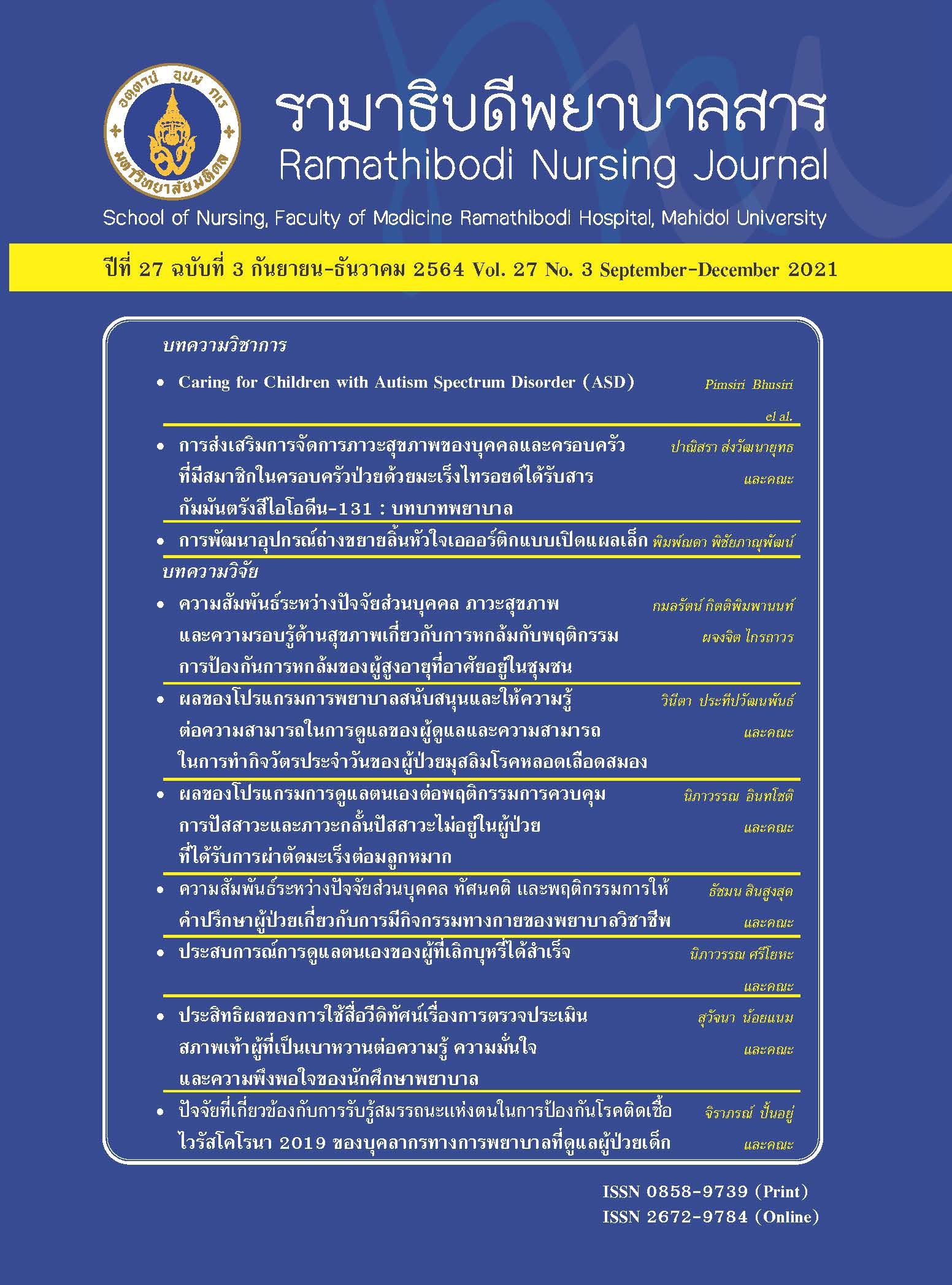ผลของโปรแกรมการดูแลตนเองต่อพฤติกรรมการควบคุมการปัสสาวะและภาวะกลั้นปัสสาวะไม่อยู่ในผู้ป่วยที่ได้รับการผ่าตัดมะเร็งต่อมลูกหมาก
Main Article Content
บทคัดย่อ
การวิิจััยครั้งนี้เป็็นการศึึกษากึ่งทดลอง เพื่อศึึกษาผลของโปรแกรมการดููแลตนเองต่อพฤติิกรรมการควบคุุมการปัสสาวะและภาวะกลั้นปัสสาวะไม่อยู่ในผู้ป่วยมะเร็งต่อมลูกหมากที่ได้รับการผ่าตัดต่อมลููกหมากออกทั้งหมด โดยใช้โปรแกรม PRO-SELF ที่ประยุุกต์จากแนวคิิดการดููแลตนเอง กลุ่มตัวอย่างคือผู้ป่วยมะเร็งต่อมลููกหมากที่่มีีภาวะกลั้นปัสสาวะไม่อยู่หลังผ่าตัดต่อมลููกหมากออกทั้งหมด เข้ารับการรักษาในหอผู้ป่วยมะเร็็งต่อลููกหมากที่่โรงพยาบาลรามาธิิบดีี จำนวน 40 ราย ได้รับการคััดเลืือกตามคุุณสมบััติิที่่ กำหนด แบ่งเป็นกลุ่มทดลองและกลุ่มควบคุุมกลุ่มละ 20 ราย เครื่่องมืือที่่ใช้ในการวิิจััยครั้งนี้ ประกอบด้วย โปรแกรมการดููแลตนเอง เก็็บรวบรวมข้อมููลโดยใช้แบบบัันทึึกข้อมููลส่วนบุุคคล แบบประเมิินพฤติิกรรมการควบคุุมการปัสสาวะ และแผ่นทดสอบ 1 ชั่่วโมง วิิเคราะห์ข้อมููลโดยใช้สถิิติิเชิิงพรรณนา สถิิติิไควสแควส์ สถิิติิทดสอบค่าทีี สถิิติิแมนวิิทนีีย์ ยู และสถิิติิวิิลคอกสัน ผลการศึึกษาพบว่า ภายหลังการเข้าร่วมโปรแกรมการดููแลตนเอง กลุ่มทดลองมีีค่าเฉลี่่ยคะแนนพฤติิกรรมการควบคุุมการปัสสาวะสููงกว่าก่อนเข้าร่วม
โปรแกรม และสููงกว่ากลุ่มควบคุุมอย่างมีีนัยสำคัญทางสถิิติิ และกลุ่มทดลองมีีค่าเฉลี่่ยภาวะกลั้นปัสสาวะไม่อยู่ต่ำกว่าก่อนเข้าร่วมโปรแกรม และต่ำกว่ากลุ่มควบคุุมอย่างมีีนัยสำคัญทางสถิิติิการศึึกษานี้แสดงให้เห็็นว่าโปรแกรมการดููแลตนเองมีีผลทำให้ผู้ป่วยที่่กลั้นปัสสาวะไม่อยู่หลังการผ่าตัดต่อมลููกหมากออกทั้งหมดมีีพฤติิกรรมการดููแลตนเองดีีขึ้้น และภาวะกลั้นปัสสาวะไม่อยู่ลดลง ดังนั้นจึงควรนำโปรแกรมการดููแลตนเองนี้้ไปประยุุกต์ใช้ในผู้ป่วยมะเร็็งต่อมลููกหมากที่่ได้รับการผ่าตัดต่อมลููกหมากออกทั้งหมด เพื่่อส่งเสริิมพฤติิกรรมการควบคุุมการปัสสาวะ และลดภาวะกลั้นปัสสาวะไม่อยู่
คำสำคัญ : โปรแกรมการดููแลตนเอง ภาวะกลั้นปัสสาวะไม่อยู่ พฤติิกรรมการควบคุุมการปัสสาวะมะเร็็งต่อมลููกหมาก การผ่าตััดต่อมลููกหมากออกทั้งหมด
Article Details
บทความ ข้อมูล เนื้อหา รูปภาพ ฯลฯ ที่ได้รับการตีพิมพ์ในรามาธิบดีพยาบาลสาร ถือเป็นลิขสิทธิ์ของวารสาร หากบุคคลหรือหน่วยงานใดต้องการนำทั้งหมดหรือส่วนหนึ่งส่วนใดไปเผยแพร่หรือเพื่อกระทำการใด ใด จะต้องได้รับอนุญาตเป็นลายลักษณ์อักษรจากรามาธิบดีพยาบาลสารก่อนเท่านั้น
เอกสารอ้างอิง
Seo HJ, Lee NR, Son SK, Kim DK, Rha KH, Lee SH.Comparison of robot-assisted radical prostatectomy and
open radical prostatectomy outcomes: a systematic review and meta-analysis. Yonsei Med J. 2016;57(5):1165-77.
Information for analysis of health data, Faculty of Medicine Ramathibodi Hospital, Mahidol University. Inpatients general report who had prostate cancer and had radical prostatectomy 2016-2020; 2021 [cited 2021 March2]. Available from: https://docs.google.com/spreadsheets/d/1xU3Ta6XJdvOpDWOG1mdOXzJPN
w6TFecA/edit?dls=true#gid=1104109517 (in Thai)
Hatiboglu G, Teber D, Tichy D, Pahernik S, Hadaschik B, Nyarangi-Dix J, et al. Predictive factors for immediate
continence after radical prostatectomy. World J Urol.2016;34(1):113-20.
Haglind E, Carlsson S, Stranne J, Wallerstedt A, Wilderang U, Thorsteinsdottir T, et al. Urinary incontinence and
erectile dysfunction after robotic versus open radical prostatectomy: a prospective, controlled, nonrandomised
trial. Eur Urol. 2015;68(2):216-25.
Phlatyothin L, Rangsaritvirachot K, Kittichaiset R.Development of empowerment program in stroke patients
with urinary incontinence. Journal of Medical Department.2016;41(3):102-11. (in Thai)
Wang W, Huang QM, Liu FP, Mao QQ. Effectiveness of preoperative pelvic floor muscle training for urinary
incontinence after radical prostatectomy: a meta-analysis.BMC Urol. 2014;14:99.
Ratwisai P, Srichaikul B, Songkasri C. Kegel and urinary bladder training exercise program for urinary incontinence in elderly females at Na Tan subdistrict, Tha Khantho district, Kalasin province. Journal of the Office of DPC 7 Khon Kaen. 2017;1:47-57. (in Thai)
Sam N. M.S. Psychology dictionary professional reference. Behavior control; 2013 [cited 2021 March 1].
Available from: https://psychologydictionary.org/behavior-control/
Dubbelman Y, Groen J, Wildhagen M, Rikken B, Bosch R. The recovery of urinary continence after radical
retropubic prostatectomy: a randomized trial comparing the effect of physiotherapist-guided pelvic floor muscle
exercises with guidance by an instruction folder only. BJUInt. 2010;106(4):515-22.
Santa Mina D, Au D, Alibhai SMH, Jamnicky L, FaghaniN, Hilton WJ, et al. A pilot randomized trial of conventional versus advanced pelvic floor exercises to treat urinary incontinence after radical prostatectomy: a study protocol.BMC Urol. 2015;15:94.
Prangprasit O, Danaidutsadeekul S, Thosingha O, Ramart P. The relationships among physical activity, knowledge,comorbidity and quality of life in patients with urinary incontinence following radical prostatectomy. Nursing Science Journal of Thailand. 2013;31(4):55-65. (inThai)
Narasong P, Tridech P, Pandi W, Nualyong C. Quality of life of prostate cancer patients with robotic assisted
laparoscopic radical prostatectomy in Siriraj Hospital.Siriraj Nursing Journal. 2011;4(1):43-55. (in Thai)
Santa Mina D, Matthew AG, Hilton WJ, Au D, Awasthi R, Alibhai SMH, et al. Prehabilitation for men undergoing
radical prostatectomy: a multi-centre, pilot randomized controlled trial. BMC Surg. 2014;14: article number: 89.
Newman DK, Burgio KL. Conservative management of urinary incontinence: behavioral and pelvic floor therapy and urethral and pelvic devices. In Alan J. Wein, Louis R.Kavoussi, Alan W. Partin, Craig A. Peters, editors.
Campbell-Walsh Urology. 11th ed. China: Elsevier; 2016.p.1875-98.
Rajkowska-Labon E, Bakula S, Kucharzewski M,Sliwinski Z. Efficacy of physiotherapy for urinary
incontinence following prostate cancer surgery. BioMed Res Int. 2014;2014: article ID: 785263.
West CM, Dodd MJ, Paul SM, Schumacher K, Tripathy D, Koo P, et al. The PRO-SELF: pain control program-an
effective approach for cancer pain management. Oncol Nurs Forum. 2003;30(1):65-73.
Dodd MJ, Miaskowski C. The PRO-SELF program: aself-care intervention program for patients receiving cancer
treatment. Semin Oncol Nurs. 2000;16(4):300-8.
Erdfelder E, Faul F, Buchner A. GPOWER: a general power analysis program. Behav Res Methods Instrum &
Comput 1996;28:1-11.
Kongtragul J, Tukhanon W, Tudpudsa P, Suedee K,Tienchai S, Leewansangtong S, et al. Effect of adding
concentration therapy to kegel exercise to improve continence after radical prostatectomy, randomized
control. J Med Assoc Thai. 2014;97(5):1-5.
Abdel-fattah M, Barrington JW, Youssef M. The standard 1-hour pad test: does it have any value in clinical practice.Eur Urol. 2004;46(3):377-80.
Lucas MG, Bosch RJL, Burkhard FC, Cruz F, Madden TB, Nambiar AK, et al. EAU guidelines on assessment
and nonsurgical management of urinary incontinence. EurUrol. 2012;62(6):1130-42.
Aree-Ue S, Youngcharoen P. The 6 item cognitive function test-Thai version: psychometric property testing.
Ramathibodi Nursing Journal. 2020;26(2):188-202.(in Thai)
Kochakarn V, Viseshsindh W, Pummangura W.Management of urinary incontinence.Bangkok: Idea
Instant Printing; 2010. (in Thai)
O´Sullivan R, Karantanis E, Stevermuer TL, Allen W,Moore KH. Definition of mild, moderate, and severe
incontinence on the 24-hour pad test. BJOG.2004;111(8):859-62.
Prasertsuk N, Kerdnaimongkol U, Sa-artyen K.Development of holistic creative learning skills for older
person in rural area of Thailand: mental health care dimension. Silpakorn Education Research Journal.
;8(2):49-61. (in Thai)
Ronnarithivichai C, Sujijantararat R, Petchpansri S,Thaweeboon T, Sujijantararat P, Meehadsai N. Effect of
symptom management model on duration of bladder control in elderly women with urinary incontinence. Journal of Nursing Science. 2013;31(2):7-15. (in Thai)
Patel MI, Yao J, Hirschhorn AD, Mungovan SF.Preoperative pelvic floor physiotherapy improves
continence after radical retropubic prostatectomy. Int JUrol. 2013;20(10):986-92.
Jeong SJ, Yeon JS, Lee JK, Cha WH, Jeong JW, Lee BK,et al. Development and validation of nomograms to predict the recovery of urinary continence after radical prostatectomy: comparisons between immediate, early,
and late continence. World J Urol. 2014;32(2):437-44.


